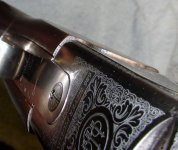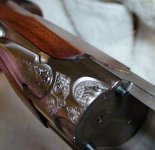I refinished a Beretta 686 SP1 28ga stock because of water spotting. I followed advice found on this forum by cleaning off the old finish and hand-rubbing in 4 coats of tung oil. It looks great. The problem is that the wood apparently was very dry (even though the gun is practically new) to start with has become swollen as a result of the oil penetration, particularly in the thin areas where the firing mechanism fits into the stock. There is now about 1 - 1.5 mm protrusion of the wood above the metal of the mechanism. Is there a non-destructive way (not involving removing the offending wood by sanding or filing) to correct it?
You are using an out of date browser. It may not display this or other websites correctly.
You should upgrade or use an alternative browser.
You should upgrade or use an alternative browser.
Stock Refinishing Issue
- Thread starter morrowjg
- Start date
603Country
New member
I've used Tung oil on many small wooden things (spoons, spatulas, etc) and haven't run into that problem. I'm with you in thinking that wood removal is the last option, but I don't know what else to suggest. Is there any chance that dried Tung oil on the inner sides of the grips is what's causing the grips to not fit properly?
Dixie Gunsmithing
Moderator Emeritus
You might try using a hair dryer, to sweat some of the oil out, but once it has swelled the grain, you may have no alternative but to refit the stock. This is why I use Tru-Oil, etc, as it does not saturate the wood; it really stays mostly on top of it.
Thanks for taking the time to reply. I will try a little heat to see if it will get some of the oil out and let the wood shrink a little. I think that Dixie Gunsmithing is, unfortunately, correct and that the stock will need to be refit. The wood in that area is pretty thin from the outset and I don't believe that I'm skilled/experienced enough to do the job without doing irreparable damage. That would make it time to call in the professionals!
603Country
New member
Once the Tung oil has dried, I'm thinking that use of heat won't help. But...it's worth a try. If the OP is in central Texas, bring the gun and grips and let me see if I can help. I'm a woodworker.
603Country
New member
For some reason, I originally thought that you were talking about pistol grips. Guess I should pay more attention. Good thing you aren't driving this way for my help. Being a stock for a 28 ga shotgun changes things a bit, but not necessarily for the worse. Might actually make it easier to remove the wood satisfactorily. Might I suggest that you find a high level woodworker to have a look at the problem. You can probably find one by calling a Woodcraft location in Atlanta. They are likely to know the guys that could take on a project like yours. And they teach woodworking classes, so maybe one of their people could do the work. Or a gunsmith might be able to connect you with someone.
If the wood of the stock isn't stained in any way, removal of wood shouldn't cause a change in wood color. It'll remove the cured tung oil and some wood (as required), but I'd expect that reapplication of the tung oil to the newly surfaced stock should bring that area to the same color/tone as the rest of the stock. Worst case is that the stock, once modified to fit, would need to be completely sanded and then re-finished. I just redid one of my rifle stocks. Took me a couple of weeks, but it looks terrific.
I wish I was within driving distance so I could have a look at the problem.
If the wood of the stock isn't stained in any way, removal of wood shouldn't cause a change in wood color. It'll remove the cured tung oil and some wood (as required), but I'd expect that reapplication of the tung oil to the newly surfaced stock should bring that area to the same color/tone as the rest of the stock. Worst case is that the stock, once modified to fit, would need to be completely sanded and then re-finished. I just redid one of my rifle stocks. Took me a couple of weeks, but it looks terrific.
I wish I was within driving distance so I could have a look at the problem.
1 to 1.5 mm should affect anything. 1mm = 3/64". 1.5mm = 1/64" Nor should tung oil cause any swelling. Sanding it won't hurt anything.
Ain't no hair dryer going to do anything to dry tung oil. And Tru-oil has tung oil in it along with a bunch of other chemicals to hasten drying. Isn't any better.
Ain't no hair dryer going to do anything to dry tung oil. And Tru-oil has tung oil in it along with a bunch of other chemicals to hasten drying. Isn't any better.
Dixie Gunsmithing
Moderator Emeritus
Tru-Oil may have some Tung oil in it, but it contains boiled Linseed oil, and some additive to speed the drying. They say it contains three oils.
My guess is that heat won't help unless it was used before it dries. About the only thing you can do, then, is re-sand it, and fit it where it swelled. Just use some emery paper and some small sticks to back it up, that are close to the shape you want to modify, and take a little off at a time until it fits.
There is another brand of stock finish called Gun Sav'r in an aerosol, and they have a rub on called Pro Custom Oil. I have seen good results with both, and do use it sometimes. The aerosol, I hand rub when spraying the stock for the first coat. The Gun Sav'r and Pro Custom Oil is Tung oil & Urethane.
My guess is that heat won't help unless it was used before it dries. About the only thing you can do, then, is re-sand it, and fit it where it swelled. Just use some emery paper and some small sticks to back it up, that are close to the shape you want to modify, and take a little off at a time until it fits.
There is another brand of stock finish called Gun Sav'r in an aerosol, and they have a rub on called Pro Custom Oil. I have seen good results with both, and do use it sometimes. The aerosol, I hand rub when spraying the stock for the first coat. The Gun Sav'r and Pro Custom Oil is Tung oil & Urethane.
Photo
This shows what happened. The stock fit flush until I applied the tung oil. Notice that the opening for the trigger mechanism is now "V" shaped, in that it is wider at the open end than at the base (not 'U' shaped as before the oiling). The more I look at it the more I think that it may be unsalvagable. I changed the resolution on the picture without a loss of quality. I have some additional pictures that I can upload if that will help. This one shows all of the issues.
This shows what happened. The stock fit flush until I applied the tung oil. Notice that the opening for the trigger mechanism is now "V" shaped, in that it is wider at the open end than at the base (not 'U' shaped as before the oiling). The more I look at it the more I think that it may be unsalvagable. I changed the resolution on the picture without a loss of quality. I have some additional pictures that I can upload if that will help. This one shows all of the issues.
Attachments
IMO, there is no practical difference between true "tung" oil, and BC's Tru-Oil. They're both drying oils with essentially the same properties- as are linseed and soybean. True tung oil is expensive, and takes forever to dry- I've never used it. Most of the commercial products including tung, linseed and soybean contain drying agents.
I've not seen that much dimensional change from Tru-Oil. Slightly raised grain, sure- which is why a light sanding between coats is needed.
You said you refinished- but you did not mention the stain used. Did you use an oil based stain- or water based? A water based stain will swell the wood grain and could cause the problem you encountered. The wood changed dimensionally along the end grain only; the area of the trigger guard still fits flush.
My bet is that it was the stain you used, and not the oil finish, that caused your issues.
I've not seen that much dimensional change from Tru-Oil. Slightly raised grain, sure- which is why a light sanding between coats is needed.
You said you refinished- but you did not mention the stain used. Did you use an oil based stain- or water based? A water based stain will swell the wood grain and could cause the problem you encountered. The wood changed dimensionally along the end grain only; the area of the trigger guard still fits flush.
My bet is that it was the stain you used, and not the oil finish, that caused your issues.
Dixie Gunsmithing
Moderator Emeritus
Did it feel like anything was rubbing as you slid the stock onto the receiver? What about how tight it fit when the bottom tang for the trigger and the top one for the safety was seated back into the stock? The reason I ask is, it looks to fit tight at the rear of the tangs, and spread open as it goes forward toward the main receiver. If it swelled at the rear, and is forced on, it could eventually cause a crack to appear at the rear. In that, if it does fit tightly there, you might open that, and both ears of the stock would them come inward.
If you have a caliper, measure the stock while on and off the gun, where it meets the main portion of the receiver, at the front, and that will tell if the stocks ears are being forced open when its slid on.
If you have a caliper, measure the stock while on and off the gun, where it meets the main portion of the receiver, at the front, and that will tell if the stocks ears are being forced open when its slid on.
No stain was used. Only tung oil rubbed in by hand. And, to Dixie Gunsmithing, you are correct. It does fit well at the rear of the tangs and it does splay out, as I mentioned, in a V fashion rather than a U, where the tangs are equidistant throughout their length. It does not feel to be tighter than when I removed the firing mechanism. I am applying a little heat at the base of the tangs with a lamp and some inward pressure on the tips of the tangs with a large woodworkers clamp. I'll let you know how that works out.
tobnpr is correct. When I checked the tung oil preparation that I used, there it was, right at the top of the ingredients, 'contains aliphatic hydrocarbons.' I had to dust off some organic chemistry from too long ago to recall exactly what that meant. That's the culprit, I'll wager. So, I'll go from here, probably with some very careful, gentle, woodworking.


